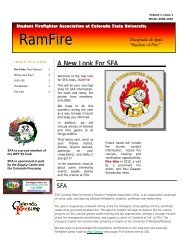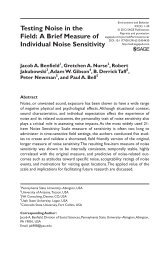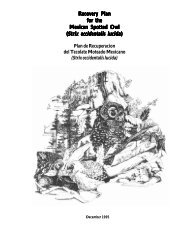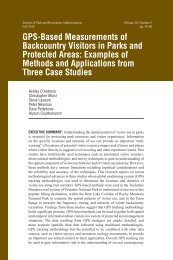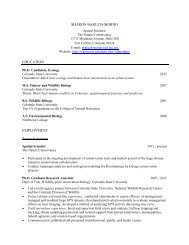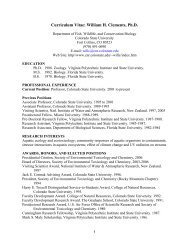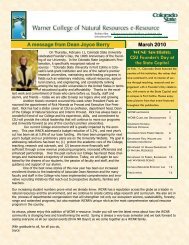Amy Carrozzino-Lyon
Amy Carrozzino-Lyon
Amy Carrozzino-Lyon
Create successful ePaper yourself
Turn your PDF publications into a flip-book with our unique Google optimized e-Paper software.
Wildlife professionals and recreational users<br />
of wildlife management areas in Virginia:<br />
An application of co-orientation to evaluate attitudes toward land<br />
management<br />
<strong>Amy</strong> L. <strong>Carrozzino</strong>-<strong>Lyon</strong><br />
Steve L. McMullin<br />
James A. Parkhurst<br />
Funded in part by Pittman-Robertson Federal Aid to Wildlife Restoration Project-WE99R.<br />
1
Wildlife management areas<br />
• WMA Mission:<br />
– Create, maintain &<br />
enhance wildlife<br />
habitat<br />
– Hunting & fishing<br />
opportunities and<br />
other forms of wildliferelated<br />
recreation<br />
• Broadening stakeholders = changes in attitudes<br />
toward land management?<br />
2
Managing in the Public Trust<br />
• Natural resources as a<br />
public resource, held in<br />
trust by NR managers<br />
• NR managers make<br />
decisions, conduct<br />
management activities<br />
on behalf of public<br />
– Same values, opinions, &<br />
perceptions?<br />
Absher et al. 1988; Bradley and Kearney 2007; Kearney et al. 1999; Peyton and Langenau 1985<br />
3
Co-orientation theory:<br />
Organization-public relationship<br />
• Beyond audience characterization<br />
– Extent to which parties share views<br />
– Identify and measure similarities and differences<br />
in actual and perceived views and assumptions<br />
• Ask participants to provide<br />
own and predicted responses<br />
Cutlip et al. 2000; Dozier et al. 1995; Grunig 2001<br />
4
Potential co-orientation outcomes<br />
Agreement<br />
Low<br />
High<br />
Accuracy<br />
Low High<br />
False consensus<br />
do not share views, do<br />
not recognize other<br />
group's views<br />
False conflict<br />
share views, but do not<br />
recognize shared views<br />
Dissensus<br />
do not share views, but<br />
recognize differences<br />
True consensus<br />
similar views and<br />
recognize shared views<br />
Broom &<br />
Dozier, 1990;<br />
Dozier &<br />
Ehling, 1992<br />
5
Objective<br />
Apply co-orientation to describe attitudes of agency<br />
managers and a diversity of wildlife management<br />
area recreational users toward land management<br />
Little North Mountain WMA<br />
6
• Paper (n=1,227) and<br />
web-based (n=360)<br />
versions<br />
Survey methods<br />
– User preference<br />
indicated during on-site<br />
interviews (2009-10)<br />
• VDGIF agency survey<br />
– Web-based (n=81)<br />
March- April 2011<br />
7
Co-orientation of managers and<br />
VDGIF’s attitudes toward<br />
land management<br />
Congruency*<br />
VDGIF’s perception of<br />
WMA users’ attitudes<br />
Adapted from McLeod and Chaffee 1973:484<br />
recreational users<br />
Agreement<br />
WMA users’ attitudes<br />
toward land management<br />
Congruency*<br />
WMA users’ perception of<br />
DGIF’s attitudes<br />
*Perceived agreement<br />
8
Results<br />
WMA recreational users VDGIF managers<br />
n = 726 (50% response rate) n = 77 (95% response rate)<br />
94% male, 6% female 90% male, 10% female<br />
Mean age: 49 years<br />
(range: 20-89 yrs.)<br />
85% held a valid VA hunting<br />
and/or fishing license<br />
Mean age: 48 years<br />
(range: 29-63 yrs.)<br />
• WMA respondents were representative of the<br />
user population<br />
9
WMA users: response frequencies<br />
timber harvest, improve habitat<br />
timber harvest, diseased trees<br />
timber harvest, forest unchanged<br />
prescribed burn, risk minimized<br />
prescribed burn, historic role of fire<br />
prescribed burn, habitat diversity<br />
herbicide, invasive species<br />
herbicide, safe for wildlife<br />
herbicide, treat undesirable only<br />
mechanical, open fields and clearings<br />
mechanical, pollution prevented<br />
mechanical, wildlife displaced temp.<br />
0% 10% 20% 30% 40% 50% 60% 70% 80% 90% 100%<br />
10<br />
SA<br />
A<br />
N<br />
D<br />
SD
VDGIF managers: response frequencies<br />
timber harvest, improve habitat<br />
timber harvest, diseased trees<br />
timber harvest, forest unchanged<br />
prescribed burn, risk minimized<br />
prescribed burn, historic role of fire<br />
prescribed burn, habitat diversity<br />
herbicide, invasive species<br />
herbicide, safe for wildlife<br />
herbicide, treat undesirable only<br />
mechanical, open fields and clearings<br />
mechanical, pollution prevented<br />
mechanical, wildlife displaced temp.<br />
0% 10% 20% 30% 40% 50% 60% 70% 80% 90% 100%<br />
11<br />
SA<br />
A<br />
N<br />
D<br />
SD
Did majority agree with VDGIF managers?<br />
(Agreement)<br />
Frequency analysis: WMA user co-orientation<br />
No<br />
Yes<br />
Did majority recognize VDGIF managers’ position? (Accuracy)<br />
No Yes<br />
False consensus Dissensus<br />
timber harvest, forest unchanged timber harvest, improve habitat<br />
timber harvest, diseased trees<br />
False conflict True consensus<br />
prescribed burn, risk minimized<br />
prescribed burn, historic role of fire<br />
prescribed burn, habitat diversity<br />
herbicides, invasive species<br />
herbicides, safe for wildlife<br />
herbicides, treat undesirable only<br />
mechanical, open fields & clearings<br />
mechanical, pollution prevented<br />
mechanical, wildlife displaced temp.<br />
12
Did majority agree with WMA users?<br />
(Agreement)<br />
No<br />
Yes<br />
Frequency analysis: VDGIF co-orientation<br />
Did majority recognize WMA users’ position? (Accuracy)<br />
No Yes<br />
False consensus Dissensus<br />
timber harvest, improve habitat timber harvest, forest unchanged<br />
timber harvest, diseased trees<br />
False conflict True consensus<br />
prescribed burn, risk minimized<br />
prescribed burn, historic role of fire<br />
prescribed burn, habitat diversity<br />
herbicides, invasive species<br />
herbicides, safe for wildlife<br />
herbicides, treat undesirable only<br />
mechanical, open fields & clearings<br />
mechanical, pollution prevented<br />
mechanical, wildlife displaced temp.<br />
13
Frequency analysis summary<br />
• High agreement and accuracy for majority of<br />
both groups<br />
– Timber harvest as exception<br />
• Managers agreed with most practices more<br />
strongly than WMA users<br />
– Timber harvest as exception<br />
• In some cases, WMA users were neutral,<br />
agreed less strongly<br />
– Level of agreement? (Chi-square)<br />
14
Agreement (shared views)<br />
Statistical analysis: WMA user co-orientation<br />
Low<br />
High<br />
Accuracy<br />
Low High<br />
False consensus Dissensus<br />
timber harvest, improve habitat herbicides, treat undesirable only<br />
timber harvest, diseased trees<br />
timber harvest, forest unchanged<br />
prescribed burn, historic role of fire<br />
prescribed burn, habitat diversity<br />
herbicides, invasive species<br />
mechanical, open fields & clearings<br />
mechanical, wildlife displaced temp.<br />
False conflict True consensus<br />
prescribed burn, risk minimized mechanical, pollution prevented<br />
herbicides, safe for wildlife<br />
15
Agreement (shared views)<br />
Low<br />
High<br />
Statistical analysis: VDGIF co-orientation<br />
Accuracy<br />
Low High<br />
False consensus Dissensus<br />
timber harvest, improve habitat timber harvest, forest unchanged<br />
prescribed burn, historic role of fire mechanical, open fields & clearings<br />
prescribed burn, habitat diversity timber harvest, diseased trees<br />
herbicides, invasive species mechanical, wildlife displaced temp.<br />
herbicides, treat undesirable only<br />
False conflict True consensus<br />
herbicides, safe for wildlife prescribed burn, risk minimized<br />
mechanical, pollution prevented<br />
16
Statistical analysis summary<br />
• Low agreement and low accuracy for both<br />
groups<br />
– Statistically different views as a result of level of<br />
agreement, predicted level of agreement<br />
• Managers more accurate at predicting overall<br />
positions of WMA users<br />
17
• Considering either<br />
method of analysis<br />
alone may lead to<br />
different conclusions<br />
Discussion<br />
– Frequencies: optimistic,<br />
may mask potential<br />
issues<br />
– Statistics: statistical<br />
significance may not be<br />
managerial<br />
18
Discussion<br />
• Timber harvest: statistical and managerial<br />
significance<br />
– Disagreement present, sometimes unrecognized<br />
– Area in need of attention, may be difficult to address<br />
• Other practices have potential to become<br />
problematic<br />
– Differences in level of agreement<br />
• e.g., prescribed burning for habitat diversity<br />
– Neutral attitudes may change as a result of new<br />
information and experiences<br />
19
Management implications<br />
• Co-orientation has benefits for agencies<br />
– Recognize disagreement and misunderstandings<br />
– Pro-actively identify areas of controversy<br />
– Effectively engage with broadening stakeholders<br />
• Further application in natural resources<br />
– Appropriate analysis depends on objectives<br />
– Frequency and statistical analyses aided in<br />
identifying managerial importance<br />
20
Goshen WMA<br />
Questions or<br />
comments<br />
21
Literature Cited<br />
• Absher, J.D., L.H. McAvoy, R.J. Burdge, and J.H. Gramann. 1988. Public and commercial managers<br />
predicting recreationist opinions. Journal of Park and Recreation Administration 6:66-77.<br />
• Bradley, G.A., and A.R. Kearney. 2007. Public and professional responses to the visual effects of timber<br />
harvesting: different ways of seeing. Western Journal of Applied Forestry 22:42-54.<br />
• Broom, G.M., and D.M. Dozier. 1990. Using research in public relations: applications to program<br />
management. Prentice Hall, Englewood Cliffs, New Jersey.<br />
• Cutlip, S.M., A.H. Center, and G.M. Broom. 2000. Effective Public Relations, 8th ed. Prentice Hall, Upper<br />
Saddle River, New Jersey, USA.<br />
• Dozier, D. M., & Ehling, W. P. (1992). Evaluation of public relations programs: What the literature tells us<br />
about their effects. In J. E. Grunig (Ed.). Excellence in public relations and communication management<br />
(pp. 159–184). Hillsdale, New Jersey ,Lawrence Erlbaum.<br />
• Dozier, D.M., L.A. Grunig, and J.E. Grunig. 1995. Manager’s guide to excellence in public relations and<br />
communication management. Lawrence Erlbaum Associates, Mahwah, New Jersey, USA.<br />
• Grunig, J.E. 2001. Two-way symmetrical public relations: past, present, and future. Pages 11-30 in R.L.<br />
Heath, ed., Handbook of Public Relations. Sage Publications, Thousand Oaks, California, USA.<br />
• Kearney, A.R., G. Bradley, R. Kaplan, and S. Kaplan. 1999. Stakeholder perspectives on appropriate forest<br />
management in the Pacific Northwest. Forest Science 45:62-73.<br />
• McLeod, J.M., and S.H. Chaffee. 1973. Interpersonal approaches to communication research. American<br />
Behavioral Scientist 16:469-499.<br />
• Peyton, R.B., and E.E. Langenau. 1985. A comparison of attitudes held by BLM biologists and the general<br />
public towards animals. Wildlife Society Bulletin 13:117-120.<br />
22



